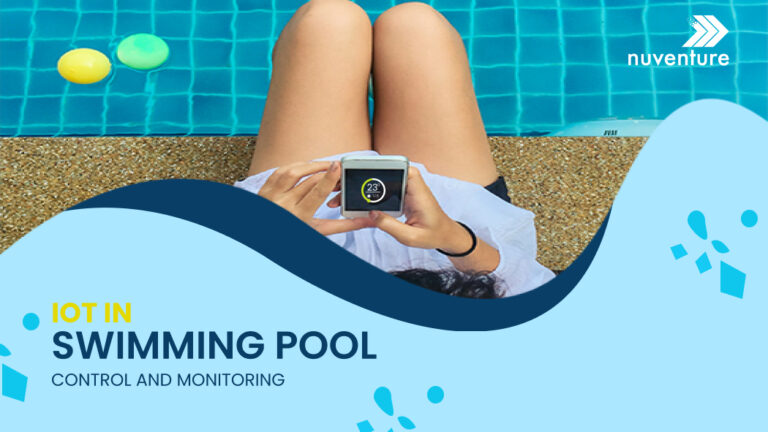Swimming pools are a great source of relaxation and entertainment, but managing them efficiently can be challenging. Fortunately, the rise of IoT (Internet of Things) technology has paved the way for smart swimming pool monitoring and control systems. By integrating IoT devices and sensors, pool owners can ensure optimal conditions, enhance safety, and simplify maintenance tasks. This blog post will explore the benefits and functionalities of smart swimming pool monitoring and control systems with IoT.
Components Of a Smart Swimming Pool System
A. Sensors and Data Collection-
Water quality sensors: These sensors measure various parameters of the water, such as pH levels, chlorine levels, temperature, and conductivity. They provide real-time data on the pool water’s quality and chemical composition, ensuring optimal swimming conditions and maintaining a healthy environment.
Environmental sensors: These sensors monitor various environmental factors surrounding the pool. They include:
Humidity sensors: By measuring the humidity levels in the pool area, these sensors help maintain a comfortable atmosphere and prevent issues like excessive moisture or condensation.
UV sensors: UV sensors detect the intensity of ultraviolet radiation in the pool area, allowing for appropriate measures to protect swimmers from overexposure to harmful UV rays.
Ambient temperature sensors: These sensors measure the air temperature surrounding the pool, providing valuable data for maintaining optimal water temperature and adjusting heating or cooling systems accordingly.
Atmospheric pressure sensors: Monitoring atmospheric pressure helps detect changes in weather conditions, allowing the system to adjust pool settings or prepare for severe weather events.
B. Connectivity and Data Transmission:
Connectivity options: Smart swimming pool systems offer various connectivity options for seamless communication and control. Wi-Fi connectivity allows users to access and manage the pool system remotely via smartphones, tablets, or web interfaces. Bluetooth connectivity enables direct communication between the pool system and nearby devices, offering convenient control within a limited range. Cellular connectivity allows remote access and control from anywhere, making it ideal for monitoring and managing the pool system when no local Wi-Fi network is available.
Data transmission: The collected sensor data is transmitted through the chosen connectivity option to a central control unit or a cloud-based platform. This facilitates real-time monitoring and analysis of pool conditions, enabling proactive maintenance, timely adjustments, and swift response to any issues. The data can be used to generate insights, identify trends, and optimize pool operations, and energy efficiency.
Working Of Smart Swimming Pool Monitoring and its Benefits
Smart swimming pool monitoring systems utilize a combination of sensors, wireless communication technologies, and cloud-based data analysis to provide real-time monitoring of water quality and overall pool performance. The sensors installed in the pool continuously measure various parameters such as pH levels, chlorine levels, temperature, turbidity, and conductivity. The data collected by the sensors is transmitted wirelessly to a central hub or gateway device, which in turn sends the data to the cloud for analysis.
In the cloud, advanced algorithms and machine learning models process the data to identify any potential issues or deviations from normal operating conditions. This analysis can help identify problems such as leaks, clogs, equipment malfunctions, and other issues that may lead to reduced water quality or safety hazards.
Authorities can take the necessary actions in accordance with data calculation with the use of IoT and Edge devices. The use of staff notification interfaces and on-site alert systems can be advantageous for these swimming pools. Therefore, integrating technology into swimming pools can bring about a number of improvements, such as:
- Ensuring cleaner water by preventing all forms of water pollution.
- Making accurate decisions by collecting and analyzing data.
- Anticipating maintenance needs through advanced analysis for optimal pool performance.
- Providing real-time monitoring and immediate alerts in case of unexpected exposure to pollutants.
- Prompt response enabled by IoT-based alert systems.
- Guaranteeing chemical balance and a safe experience for users.
- Tracking and analyzing energy consumption patterns in swimming pools.
- Offering a unified web dashboard for convenient access and management of smart swimming pools.
Conclusion
In conclusion, smart swimming pool monitoring and control systems using IoT technology provide convenient and efficient ways to monitor and manage pool conditions. By integrating sensors, connectivity options, and data transmission, these systems enable real-time monitoring, proactive maintenance, and optimized pool operations. With improved water quality, energy efficiency, and remote access capabilities, smart pool systems enhance the overall swimming experience while ensuring convenience and peace of mind for pool owners and operators. The future of swimming pool management with IoT holds great potential for advancements. We can anticipate further integration of artificial intelligence and machine learning algorithms, enabling more sophisticated data analysis and predictive capabilities. This will result in proactive maintenance, precise water quality monitoring, and optimized resource allocation.


